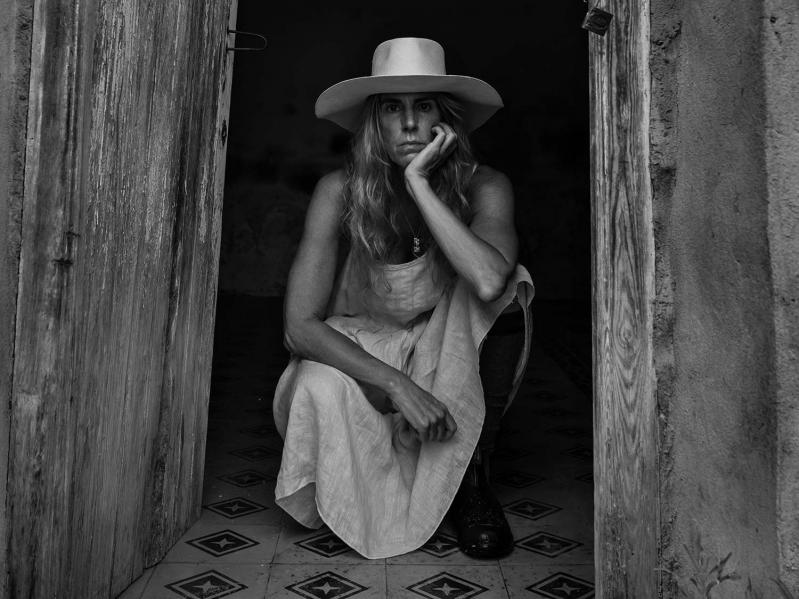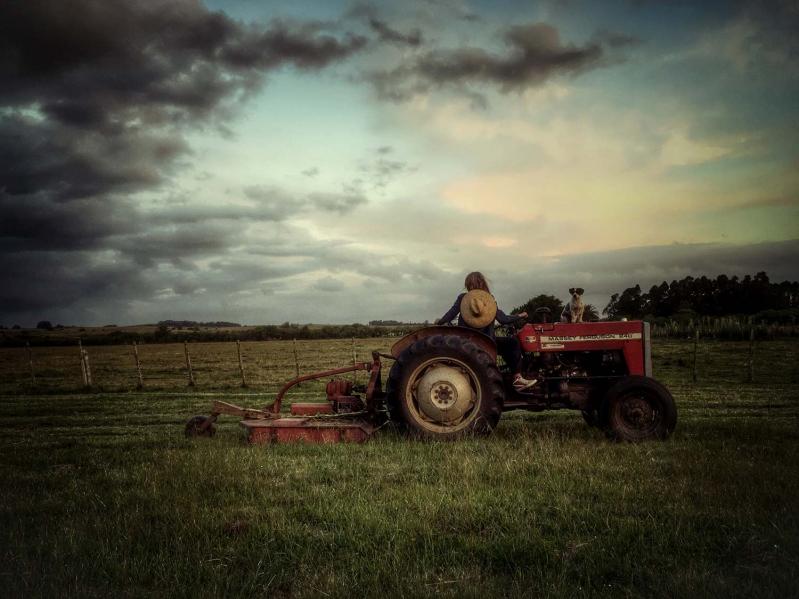"I am by no means a Donald Judd, but," said Heidi Lender, trailing off during a recent Zoom call, pinkish afternoon light flooding the room behind her.
It was a Texas-sized "but," so she paused for a while to reflect upon the late artist Donald Judd, who transformed Marfa, the remote, far-westerly outpost in supersized Texas, into a cultural mecca for the global aesthete.
"Marfa mushroomed out of a love for the arts in the middle of nowhere," said Ms. Lender, an American-born, peripatetic writer and photographer who once lived on the South Fork. Marfa came up often in conversation because Ms. Lender seems to be at the center of a similar burgeoning -- over 5,000 miles away, in Pueblo Garzon, a sleepy village about 90 miles east of Montevideo, Uruguay, her full-time home since 2014.
It's not all dirt roads and desolation in Garzon, although that is what first greets you. But enter and you'll see that it's also home to about 200 inhabitants, mostly gauchos, farmers, and a handful of second-home owners from nearby José Ignacio (often called the Hamptons of South America) or Punta del Este (the Miami of South America).
The village is undeniably atmospheric. A railway station that a century ago provided life to a once-bustling town is today derelict in an oh-so-charmingly dilapidated way. There's a striking whitewashed church and around a palm-fringed central plaza sits El Garzon, a world-class restaurant and five-room hotel built within an old general store. It was opened in 2002 by the legendary Argentine chef Francis Mallmann, regarded in equal measures as mad genius and pioneer, given that the pueblo was a true ghost town at the turn of this century.
But if Mr. Mallmann helped put Garzon on the global epicurean map, then Ms. Lender appears to be doing her part in turning this middle-of-nowhere Uruguayan village into an artsy hot spot.
"One day I just had an idea. I wanted to bring artists here. I wanted to bring my people here, bring an artist community here. I really owe this place, where I've put down my roots, as being the place where I met myself. Especially my creative self," she said. "I wanted to give others an opportunity to have a similarly transformative experience in a place far away, a place that is confronting in its quietness, in its rusticness, in its slowness. I don't think I understood what I was doing until later. But I did come to understand that this is what I wanted to share here and what I am sharing here."

In 2017, she launched Campo Garzon, a nonprofit creative institute offering art residencies, experiences, and events "under big Uruguayan skies." Three one-month-long residencies happen yearly, and since the program began more than 200 artists -- visual artists, chefs, musicians, writers, photographers, and filmmakers from all over the world -- have participated, living in an assortment of small homes and buildings, either donated by benefactors or rented by Ms. Lender.
There's also Campo Canteen, a community food and art lab within a two-bedroom home -- yet more dilapidated charm -- in the center of town. It brings "creative events, curated goods, and slow coffee to Pueblo Garzon," according to the website.
There's more to come. In 2025, Ms. Lender hopes to unveil a dedicated campus built on 30 acres, which she donated. It's designed by the Uruguayan architect Rafael Vinoly, who died in March. The complex will include residences, studios, employee housing, and a kitchen and restaurant space. "It's going to be an iconic building in South America and a legacy to Rafael, who was a master pianist and big supporter of the arts," she said.
The jewel in her creative crown, however, is the three-day Campo Artfest, which every year turns sleepy Garzon into a fantastical land of art and culture. Artfest took place from Dec. 28 to 30 and, according to Ms. Lender, 6,000 people traipsed through the village to view the work of 24 artists from disparate corners of the world. Featured installations included sound sessions, a film forum, kids and family workshops, and art discussions, as well as gaucho music. Food trucks lined the plaza, and a benefit dinner under the stars served 150 people.
In the infinitely measured, decrypted, and commodified modern world of art, the festival has turned into something that's perhaps closer to sport than art. Aficionados who attend are usually a crowd who do not so much anticipate as expect. They want the known known. But Ms. Lender, 57, seems to be giving them something of an enigma.
"The more we take care of and inspire the artists, the stronger community we build. . . . And Garzon is hands-down the most unique corner on the planet, the perfect laboratory and wide-open space for creativity to flourish," she wrote in an email, sharing her post-festival thoughts.
In many ways, Ms. Lender's Campo Garzon seems to be the culmination of a pausa, that distinctively Spanish quality known mostly to soccer players: the moment of waiting for the right decision to become clear before unleashing a pass. For her, it happened at the end of a long, personal odyssey.
Born in Connecticut to the family who created Lender's Bagels, once the world's largest producer of prepackaged bagels, Ms. Lender attended Cornell University before launching into a long career as a fashion and style writer for many of the glossies. In the aftermath of 9/11, however, she decided to move to India and study yoga.
"And that's when my freelance writing career ended," she said. "There was a huge discrepancy between the two worlds. I was going way inside with yoga. I was on an internal quest, a personal journey, and all the while I was writing about external, superficial things like shopping. It didn't make sense."
She lived in India for eight years and met a man there, an American cannabis farmer, who became her romantic partner. The couple flitted back and forth between India and the U.S. and bought a building in San Francisco that they turned into a yoga studio. In 2008, when digital photography was burgeoning, Ms. Lender began exploring the art form after receiving her first DSLR camera as a gift.
"I was so hungry for photography I ate it up." She used the then-nascent photo-sharing platform Flickr to showcase her first series, called "Once Upon," a collection of self-portraits that obscured her head or face. "It felt self-reflective. It wasn't about ego. It was quite the opposite -- an exploration of self," she said, the yogic twang undoubtedly cultivated in India still very present in her voice.
Her work won a few photography contests and led to the publication of a book about cannabis farming, published under a pseudonym since cannabis was still illegal at the time.
In 2009, she and her partner were traveling through South America when they stumbled upon Garzon.
"There were just cows and pastures everywhere. We turned into this tiny village that was like a ghost town. But walking into the old general store was like entering a secret paradise. And I could feel that something was about to happen in this little town. There was magic in the courtyard, everywhere. I knew it was the best-kept secret."
Out on a sunrise walk around Garzon, Ms. Lender happened upon a tiny yellow house with three windows, a palm tree, and acres behind it. "It caught my breath when I saw this." A week later, the couple owned the house and the accompanying 80 acres. But after nine months of living there, they broke up. "I went back to the U.S. I was so sad, I didn't know up or down," Ms. Lender recalled.
Over the next two years, she left San Francisco for good, drove across America a few times, and in 2011 landed at Napeague Harbor, where she rented a house.
"It was the only place I wanted to be because it was healing. I spent a lot of time walking on the beach, taking photos. The light was really gorgeous -- very much like Uruguay, very pink, not like the orange and reds of California. It's much softer."
She bought a house in Springs and pursued her photography -- "survival through pictures," she said -- while sporadically returning to her Uruguayan idyll. By 2014, she had bought her ex-partner out of the Garzon property and could no longer afford to keep the Springs home. So, she sold it and moved full time to Uruguay.
Today she holds a Uruguayan passport. "Although my Spanish did not improve," she said, laughing. "I've never lived in one place for as long as I've been in Uruguay, so it's a real testament to how much I love it here. And I love myself here. In this little bubble of farmland and quiet, I found my sanctuary. I can now unapologetically say that I've found a space to be by myself."
Six thousand people during Artfest, a high-end restaurant and lodging, a state-of-the-art vineyard (Bodega Garzon), and a collection of new art galleries notwithstanding, Garzon is still pretty wild, in the nicest possible sense. It still exudes the general relaxed ambience of a small town that doesn't flaunt its treasures. Ms. Lender said she's committed to protect the charm and the sanctity of the place, to keep it unblemished.
During the Northern Hemisphere summers, Ms. Lender returns to the South Fork to spread the Campo word. Last summer, the Channing Daughters family hosted a get-together under a tent to showcase the vibrant creativity flourishing in a modest South American outpost.
"It was simply to bring people together who have a desire to understand the magic of this place and be part of something that's being built -- an important center of culture that it will be in the world. I know that's strong but that's what I believe," she said, with absolute command and the ineffable sense of a woman stepping into her own destiny.




